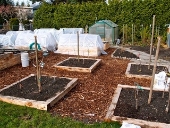


Sharla Kew wrote:I went to Amazon to try to find the goofiest, tackiest yard art possible to suggest for the Silly 250, but instead I found this which I actually really really like.

Charles Kelm wrote:I expect to continue getting a couple of gallons a month (or more) of inexpensive ($2/gallon) raw milk. I have been making lemon cheese (just heating the milk to 100 degrees, adding a cup or so of lemon juice per gallon and hanging the curds in cheese cloth for a few hours. It's good, but a little boring. I'd like to make something more interesting, but not too terribly difficult in the future. Have you had any success with things a little more exotic than lemon cheese? Also, what are some ideas for using up the whey? I made some lacto-fermented pickles yesterday with a half-tablespoon per pint. I've made bread with the whey in lieu of water. Any other ideas?
Emilie Thomas-Anderson wrote:Hi Erica! I was wondering what your suggestions might be for preserving Fuyu persimmons. My dad planted something like a dozen of these trees back when I was a kid, hoping I'd set up a roadside stand and sell them. (Which I never ended up doing, but heck, I probably should!) So we've always got TONS of them this time of year - way more than we could ever use! I've dried them, sliced, with great success, and have waited for them to get mushy like a Hachiya and frozen the pulp. Do you have other suggestions for using them up? Even a recipe beyond sliced-in-salad or baked-in-bread would be very appreciated. Thank you!
Dayna Williams wrote:Eeek, I'm so excited to see that your book is out, Erica...I'm a big fan of your blog. So, this question is coming from a relative newbie who grew up eating absolutely everything from Safeway grocery stores.
If you were just starting out (or if you could go back and redo), what would you focus on growing or producing first? I feel like a lot of people in the like...30 and under crowd grew up cooking Hot Pockets in the microwave and find the thought self-sufficiency to be completely overwhelming. So, if you were going to break it down into baby steps, what would you recommend starting with for people who want to change their lifestyle to be more sustainable?

Nicole Alderman wrote:I'd love to hear an update, too! Also, how are your hugels (http://www.nwedible.com/half-ass-hugelkultur/) producing--they're now over 3 years old!


nancy sutton wrote:Erica, how is the Dave Wilson style 'quartet planting' fruit production coming? Enough to supply your 'canning' needs? (I doubt it, but had to ask :) Any non-performers? It's been 4 yrs now... answer is probably too long for here, but a quick sum up? And a longer report on your blog? ox
http://www.nwedible.com/backyard-orchard-culture-designing/
Nicole Alderman wrote:Erica (or anyone else)!
I’ve started making hair rinses with herbs like rosemary (for dandruff), horsetail (strengthening), chamomile (I read about it in your book, Erica!) and nasturtium (for hair growth) immersed in apple cider vinegar. Is this shelf stable? For how long?
Also, does the potency of the herb’s properties increase, decrease or stay the same over time?
Also, are the herbs more potent in a hair rinse tea made in water, or in vinegar?
I guess what I’m really asking is, how do I get the best “bang for my buck” from my herbs in terms of shelf-stability and potency.
Thank you so much!
nancy sutton wrote:I know that Erica will get to your question, John, and I apologize for 'cutting in' here, but it brought to mind this book I found fascinating... including it's unusual preservation info... (and highly recommended by Steve Solomon

http://www.amazon.com/Eat-Your-Greens-Surprising-Homegrown/dp/0865717516/ref=sr_1_1?s=books&ie=UTF8&qid=1444716769&sr=1-1&keywords=eat+your+greens+the+surprising+power+of+homegrown+leaf+crops
John Saltveit wrote:Hi Erica,
I have lots of leafy greens at various times: horseradish leaves during the growing season, leeks during the winter and spring, shotweed cress in late winter, curly mallow in summer and fall, scorzonera in spring, that I would love to preserve for other times of the year. What are your favorite ways of preserving leafy greens to maintain texture, flavor and nutrition?
Thanks,
John S
PDX OR
